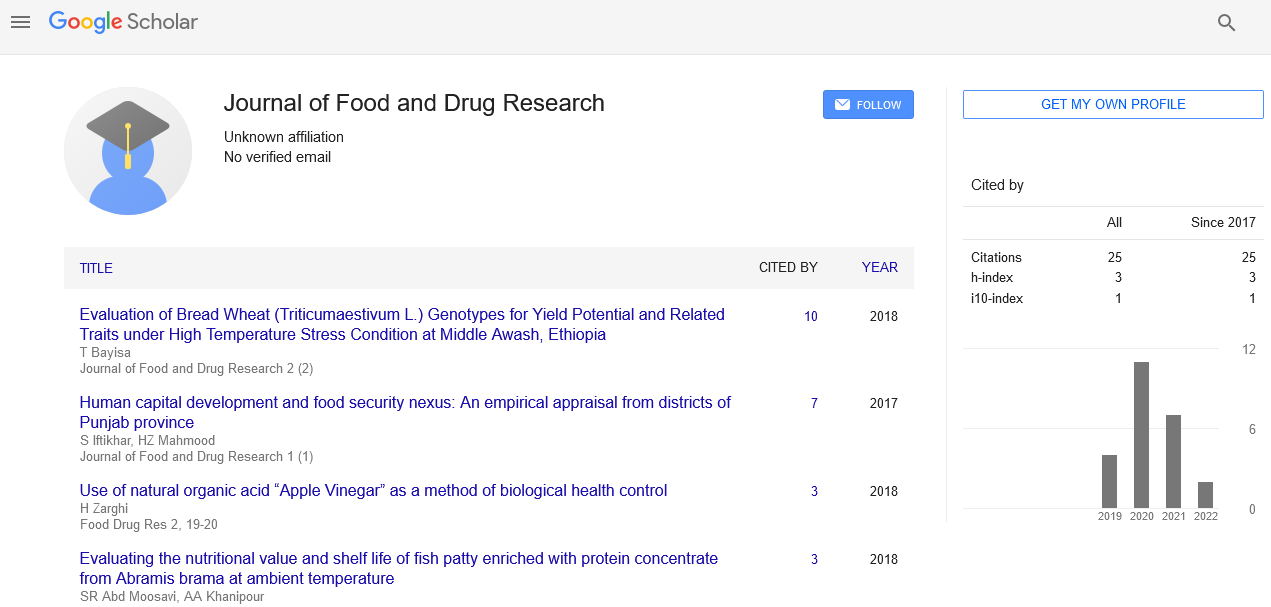A new perspective to promote the change of the food system is responsible plant nutrition
Received: 25-Jul-2022, Manuscript No. PULJFDR--22-5696; Editor assigned: 27-Jul-2022, Pre QC No. PULJFDR-22-5696 (PQ); Accepted Date: Aug 09, 2022; Reviewed: 03-Aug-2022 QC No. PULJFDR22-5696 (Q); Revised: 06-Aug-2022, Manuscript No. PULJFDR22-5696 (R); Published: 11-Aug-2022, DOI: 10.37532/ puljfdr.22.6(4).1-2
Citation: Milton D. A new perspective to promote the change of the food system is responsible plant nutrition J. Food Drug Res.2022; 6(4).1-2
This open-access article is distributed under the terms of the Creative Commons Attribution Non-Commercial License (CC BY-NC) (http://creativecommons.org/licenses/by-nc/4.0/), which permits reuse, distribution and reproduction of the article, provided that the original work is properly cited and the reuse is restricted to noncommercial purposes. For commercial reuse, contact reprints@pulsus.com
Abstract
For the transition to a global food system where mineral nutrients in agriculture must be controlled in a more holistic way, the next 10 to 20 years will be of utmost importance. Because they are one of the main forces behind maintaining global food security and enhancing human nutrition through greater crop yields and nutritional quality, fertilisers play a special role in this. Using food systems and the circular economy, a new paradigm for responsible plant nutrition pursues a number of social, environmental, and health goals. To do that, highefficiency use of all available organic and inorganic nutrient sources that is suited to the unique characteristics of food systems and agroecosystems in various world locations is required. Important steps include (i) climate-smart fertilisers, (ii) digital crop nutrition solutions, (iii) nutrient-rich crops, (iv) nutrient recovery and recycling, and (v) nutrient recovery and recycling. This transformation will lead to a new societal plant nutrition optimum rather than just an economic one. New partnerships and business models that prioritise sustainability will benefit all players in the food supply chain, including farmers and consumers. In order to provide reliable answers more quickly and on a bigger scale, research needs to become more problem-driven and combine outstanding science with entrepreneurial innovation approaches. The creation and support of the appropriate nutrient stewardship roadmaps, which should include reasonable national targets, progressive legislation, and incentives for technological and commercial innovation, should be the main emphasis of evidence-based policies
Key Words
Global food system; Mineral nutrients; Food security ; Nutritional quality
Introduction
Economic growth has historically been more rapid in areas of the world where fertiliser use and crop yields increased together. Over the past 60 years, the global agricultural output has increased at an average yearly pace of roughly 2.2%. .Additionally, albeit with significant regional variation, nutritional land productivity has increased by 2.7%–2.9% per year for calories and proteins, and between 2.1 and 4.6% for fats. Cropland intensification and expansion have been key factors in agricultural production development, and both have contributed to a sharp increase in the world's fertilizer use. With the exception of a large portion of the African continent, agricultural production growth during the Green Revolution has primarily been driven by rising yields and input efficiency though there have been times when regional land expansion was necessary to address issues with food security or take advantage of global market opportunities. The relative contribution of cropland expansion to overall production rise was higher during the 20022014 period for all of the world's most significant crops, including rice, wheat, maize, and soybean, than during the 19802002 period .Global farmland area has expanded by another 63 million ha alone in the last two decades, whereas forest land has decreased by 94 million ha (FAO, 2021). However, there were substantial social, economic, and environmental effects from both the intensification and extension of agricultural production. On the one hand, since the 1960s, increased crop yields and more productive animals have prevented the conversion of millions of hectares of natural ecosystems to farmland and rescued billions of people from starvation Intensive animal and agricultural production, on the other hand, has led to externalities that are challenging to control in order to accommodate the changing patterns of food consumption. Reactive nitrogen (N) and phosphorus (P) losses into the environment are of major concern because they have an impact on water quality, biodiversity, air quality, and Greenhouse Gas (GHG) emissions. It has been hypothesised that human interference with global N and P flows may already go beyond thresholds considered to be a safe operating environment .Although there is disagreement over the accuracy of these "Planetary Boundaries". Despite the fact that hunger and malnutrition have greatly decreased recently, they have persistently persisted in Sub-Saharan Africa (SSA) and other places including deficits in micronutrients that disproportionately affect women and children. Given that there will likely be 9.5 billion people on the planet by 2050 increasing agricultural yields will continue to be crucial for ensuring food security. However, future yield gains should also result in better environmental and socioeconomic conditions. In order to transition to a more sustainable global food system and reduce the projected $12 trillion in hidden health, environmental, and socioeconomic costs of it, the next 10 to 20 years will be crucial. Numerous mineral elements enter the food chain through crops and grasslands, i.e. from soil, fertilisers, organic manures, biological N fixation, and a few other sources. Over 20 different mineral elements are known to be essential for plant, animal, and/or human health. Plant nutrients are therefore crucial to the change of the food system because they are responsible for both primary food production and a large number of its externalities. Here, we provide a new paradigm for controlling plant nutrients throughout their life cycle, but we also make clear that there will be a wide range of objectives and solutions.






